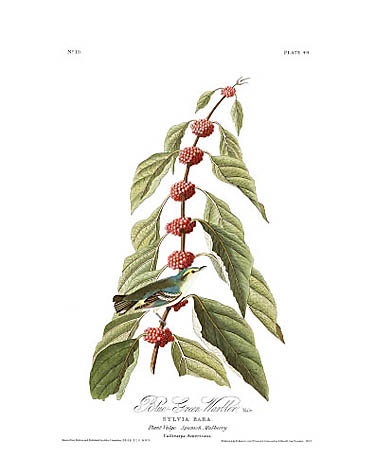|
Havell Name
Blue-Green Warbler Common Name Cerulean Warbler Havell Plate No. 049 Paper Size 39" x 28" Image Size 16" x 9" Price $ 600 |
||||
|
Ornithological Biography The Blue-green Warbler so resembles the young of the Azure Warbler, that were not the form of its bill, and some of its habits considerably different, I should be tempted to consider it a mere variety of that bird. It is equally rare in the middle districts, where I have shot only a few, and these in the dark recesses of the Great Pine Swamp.
On its passage through the States, it is found in Louisiana, where it appears in the beginning of April. This lateness of its arrival indicates its coming from a great distance, most of the other species appearing several weeks earlier. They seem to disperse soon after, as on their first appearance several may be procured in one day, as well a during their equally short stay in autumn, when again, I have shot six or seven from a single tree, on which they appeared a busily engaged as so many Titmice. I have met with them singly and far apart in Kentucky, in Ohio, upon the Missouri, and along Lake Erie, but I have never found their nest. In spring it has a soft and mellow song, which is not heard beyond the distance of a few paces. It is performed at intervals between the times at which the bird secures an insect, which it does with great expertness, either on wing, or amongst the leaves of the trees and bushes. The tops of trees, however, appear to please them best, the reverse being the case with the Azure Warbler. The Blue-green Warbler has a peculiar cunning manner of leaning downwards to view a person, or while searching for an insect, and which is very different from that of any other bird, although I am unable to describe it. While thus leaning, it moves its head sidewise so very slowly that the motion is hardly perceptible, unless much attention is paid to it. After this, it either starts off and flies to some distance from the observer, or darts toward the prey that had attracted its notice. While catching an insect on the wing, it produces a slight clicking sound with its bill, and in this respect approaches the Vireos. Like some to them also, it descends from the highest tips of the trees to low bushes, and eats small berries, particularly towards autumn, when insects begin to fail. Its flight is performed in zigzag line os a few yards, as if it were undetermined where to alight. I have found no difference between the sexes as to external appearance. The plant on which I have figured a meal is found in Louisiana, growing along the skirts of woods and by fences. It is called the Spanish Mulberry. It is a herbaceous perennial plant, attaining a height of from four to eight feet. The fruit is eaten by children but is insipid. |
|||||
|
|
|||||


| Home | Gallery | Audubon Biography | About Edition | Testimonials | Authorized Dealers | Links | Contact Us |

© Copyright 2007-2025 Zebra Publishing, LLC. | All Rights Reserved Terms of Use
Powered by Fusedog Media Group
